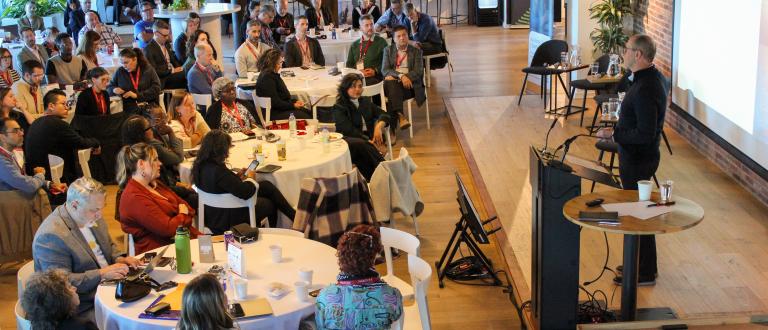The rise of generative artificial intelligence (AI), the sector’s role in disaster response, and Canada’s aging population are some of the trends we’re keeping an eye on this quarter
In our communities and networks, we’re hearing lots of excitement for spring and warm weather. However, many people are also dealing with new and unfamiliar challenges. In this edition of our quarterly blog series, we try to help you make sense of three big trends: AI, increasingly frequent weather disasters, and Canada’s aging population.
Nonprofits are adopting generative AI at similar rates to the private sector and see value in using it to replace human labour
It seems like everyone is talking about AI these days. But are people really using it? The latest results of the Canadian Survey of Business Conditions provide some useful insights. Economy-wide, 9% of businesses and organizations say they’re already using AI, while 5% say they have plans to use it. The nonprofit sector is adopting AI at a similar rate; 7% of nonprofits say they’re already using AI, and 4% say they’re planning to use it.1
The survey also provides insights into the value the sector sees in the use of generative AI. Seventy-eight percent of nonprofits see value in using AI to accelerate the development of creative content, 31% in using it to drive data-driven decision-making, and 25% in using it to improve the customer experience.2
Perhaps most interesting is the data on the connection between employment and the use of generative AI. When asked whether they see value in using AI to automate tasks to replace employees, only 1% of nonprofits said yes, compared to 14% of private sector businesses. However, nonprofits were more likely than private sector businesses (23% vs. 10%) to say they see value in using AI to minimize workforce recruitment and retention challenges. While we cannot say for certain what this means, it would appear that nonprofits are more likely to see AI as a way to address their labour force challenges rather than as a way to reduce their staff complements.
As the incidence of climate-related weather disasters increases, the nonprofit sector will be increasingly called upon to help with disaster management
Hurricane Fiona, atmospheric rivers in BC, raging forest fires across the country, and flooding in Quebec–the last few years have not been short on climate-related weather disasters. With the earth warming, the pace of major incidents is only expected to increase.
Unfortunately, the evidence indicates Canada is not prepared to handle these disasters. In 2023, we required help from 4,990 international firefighters to fight record blazes. This was in addition to deploying 5,821 domestic firefighters. Forest fires are a growing issue globally, so there is no guarantee other countries will always be able to answer our calls. In the past few years, calling on the military to help with disaster response has also become increasingly common. Between 2010 and 2016, the military was asked to provide disaster relief twice per year on average; in 2023, they helped on eight occasions. Disaster and emergency response is just one of the military’s eight core missions; a growing reliance on the military for this type of aid is straining its capacity and may impact its other core mission areas.
Many believe that training volunteers and engaging more nonprofits in disaster relief should become key components of Canada’s emergency response plan. However, training and funding will be essential for this to be safe and effective, as the data suggest that neither individual Canadians nor nonprofits are currently prepared to play this role. A 2022 Statistics Canada survey found that 50% of Canadians were somewhat or extremely concerned about the risk of a weather-related emergency impacting their household, but only 24% of households had taken any steps to prepare for a disaster over the previous year.3 With regard to nonprofits, another recent Statistics Canada survey found that only 8% thought climate change or weather would be an obstacle for them in the next three months4 while a survey conducted by Carleton University found that emergency preparedness and crisis management were a top priority for only 2% of charities.5
A model for training volunteers and engaging nonprofits can be found in Calgary. In 2013, Calgary experienced major flooding that forced tens of thousands of residents from their homes and affected 4,000 businesses and nonprofits. This disaster led to a major push to prepare individuals, families, businesses, and nonprofits for future disasters. Today, the Calgary Emergency Management Agency (CEMA) provides free online courses for adults and youth and works with more than 60 city departments, external agencies, nonprofit organizations, and community partners to prepare for and respond to disasters. By the end of 2021, 67% of CEMA members with three or more staff were trained in Emergency Operations Centre operations.
Whether or not the sector wants to be involved in disaster management, it seems clear that it will be asked to step up. Organizational leaders should begin to plan for this eventuality now.
Nonprofit sector needs to prepare for changes created by aging population
Canada’s population is aging. This fact is well known. However, insufficient attention is being paid to its implications for the sector, and few organizations seem prepared to adapt.
From a workforce perspective, there are more workers approaching retirement age than there are young workers to replace them. In March 2024, there were 12.3 million people aged 55 and older, including 4.4 million employed people. This is compared to only 4.8 million people and 2.7 million employed people in the entire 15 to 24 age bracket.6 Over the next decade, this demographic reality is expected to contribute to persistent labour shortages and increased wages for workers. These challenges will likely be magnified in the nonprofit sector because our workforce is older than the economy-wide average, and we struggle to provide competitive salaries and benefits.7
There are a range of ways this might affect nonprofits. Many organizations are likely to struggle to replace retiring employees. Young people starting their working lives in an inflationary economy will not be able to survive on the wages many nonprofits provide, regardless of their commitment to the causes the sector advances. On the flip side, some organizations will be dealing with a workforce that is older than it has ever been. The cost-of-living crisis is already forcing some workers to postpone retirement, and low wages and lack of pensions may make retirement particularly challenging for nonprofit workers. Older workers will need training to stay up-to-date on new technologies, and they may also have different needs for workplace flexibility and accommodations. Of course, older workers also bring numerous benefits with them, such as decades of experience and retention of an organization’s knowledge and networks.
In this context, it is more important than ever for the sector to find ways to offer competitive, decent employment that provides living wages and allows employees to save for their retirement.
Other implications of the aging population for the sector include the impact on demand for services and on giving and volunteering. Seniors centres, meals-on-wheels programs, long-term care homes, and social service and health organizations serving older people should prepare to serve a growing number of clients. Older Canadians have long been stalwart volunteers and donors, but their engagement has declined in recent years. Volunteer Canada has been advocating for a National Volunteer Action Strategy to address the volunteer crisis. We were pleased to see that the recent federal budget included support for this initiative.
1 Statistics Canada. Table 33-10-0784-01 Business's use of Generative AI, first quarter of 2024.
2 Statistics Canada. Table 33-10-0785-01 Value or potential value created by Generative AI, first quarter of 2024.
3 Statistics Canada. Preparing for weather-related emergencies in Canada.
4 Statistics Canada. Table 33-10-0635-01 Business or organization obstacles over the next three months, first quarter of 2023.
6 Statistics Canada. Table 14-10-0287-03 Labour force characteristics by province, monthly, seasonally adjusted.



